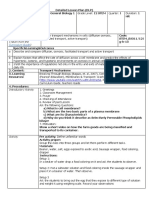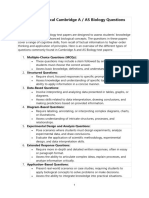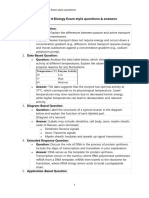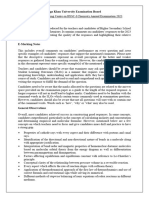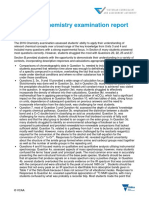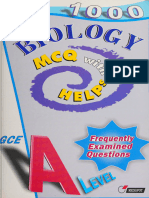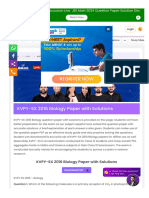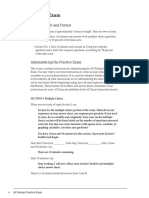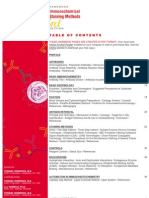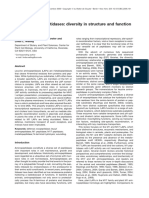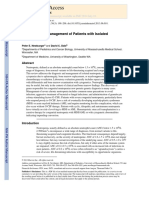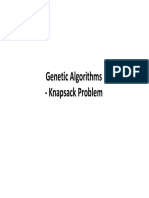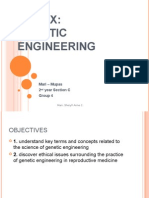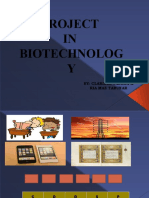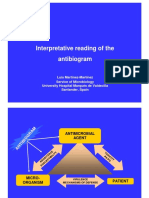Ap21 Chief Reader Report Biology
Ap21 Chief Reader Report Biology
Uploaded by
Eric ChiangCopyright:
Available Formats
Ap21 Chief Reader Report Biology
Ap21 Chief Reader Report Biology
Uploaded by
Eric ChiangOriginal Title
Copyright
Available Formats
Share this document
Did you find this document useful?
Is this content inappropriate?
Copyright:
Available Formats
Ap21 Chief Reader Report Biology
Ap21 Chief Reader Report Biology
Uploaded by
Eric ChiangCopyright:
Available Formats
Chief Reader Report on Student Responses:
2021 AP® Biology Free-Response Questions
• Number of Students Scored 230,527
• Number of Readers 1,000
• Score Distribution Exam Score N %At
5 17,048 7.4
4 44,766 19.4
3 74,683 32.4
2 69,165 30.0
1 24,865 10.8
• Global Mean 2.83
The following comments on the 2021 free-response questions for AP® Biology were written by the Chief
Reader, Amy Dykstra, Professor of Biological Sciences, Bethel University, St. Paul, MN, based on input from
Exam Leader Robert Benedetto, Central Catholic High School, Lawrence, MA. They give an overview of each
free-response question and of how students performed on the question, including typical student errors.
General comments regarding the skills and content that students frequently have the most problems with are
included. Some suggestions for improving student preparation in these areas are also provided. Teachers are
encouraged to attend a College Board workshop to learn strategies for improving student performance in
specific areas.
© 2021 College Board.
Visit College Board on the web: collegeboard.org.
Question #1 Task: Interpreting and Topic: Polycystic kidney disease
Evaluating Experimental Results and ouabain
Max. Points: 10 Mean Score: 3.68
What were the responses to this question expected to demonstrate?
This question was based on polycystic kidney disease (PKD), which results in water loss from the body and affects cell
division in kidney cells. The question described two experiments in which normal human kidney (NHK) cells and PKD cells
were treated with increasing concentrations of the steroid hormone ouabain. Experimental results were presented in two
graphs: Figure 1 showed the number of NHK and PKD cells in various ouabain concentrations, and Figure 2 showed the
percent Na + /K + ATPase activity in the various ouabain treatments. A third figure illustrated a hypothesized signal
transduction pathway initiated by ouabain binding to Na + /K + ATPase .
In part (a) students were asked to describe characteristics of the plasma membrane that prevent simple diffusion of Na + and
K + across the membrane and to explain why ATP is required for the activity of the Na + /K + ATPase . Responses were
expected to demonstrate an understanding of the structure of plasma membranes (Topic 2.4 in the AP Biology Course and
Exam Description), membrane permeability (Topic 2.5), active transport (Essential Knowledge ENE-2.E.3 in Topic 2.6), and
the function of the Na + /K + ATPase (ENE-2.G.4 in Topic 2.7).
In part (b) students were asked to identify an independent variable in the experiment represented in Figure 1, to justify the
use of NHK cells as a control, and to justify the range of ouabain concentrations used. Responses were expected to
demonstrate proficiency in identifying experimental procedures (Science Practice 3.C).
In part (c) students were asked to describe the relationship between concentration of ouabain and Na + /K + ATPase activity
in both NHK and PKD cells. Responses were expected to demonstrate proficiency in describing data from a graph (Science
Practice 4.B). Students were also asked to perform a mathematical calculation based on the data presented (Science Practice
5.A).
Part (d) described a third experiment in which scientists added an inhibitor of one of the components of the signal
transduction pathway. Students were asked to predict the effect of the inhibitor and justify their prediction. Responses were
expected to demonstrate an understanding of signal transduction pathways (Topics 4.2, 4.3, and 4.4 of the CED) and
proficiency in scientific argumentation (Science Practices 6.E and 6.C). Finally, students were asked to explain why the
concentration of cyclin proteins may increase in PKD cells treated with a specific concentration of ouabain. Responses were
expected to demonstrate an understanding that the signaling pathway stimulates gene expression (IST-3.D.2 in Topic 4.2)
and that cyclins regulate the cell cycle (IST-1.D.1 in Topic 4.7).
How well did the responses address the course content related to this question? How well did the responses
integrate the skills required on this question?
Membranes and Transport
• Many responses correctly described membrane structure – membranes are composed of lipid bilayers; phospholipids
are composed of hydrophilic heads and hydrophobic tails – but some responses did not demonstrate understanding
of how the structure of the membrane is related to its function or how hydrophilic and hydrophobic molecules
interact with their environments.
• There was some confusion about the differences between simple diffusion, facilitated diffusion, and active transport.
© 2021 College Board.
Visit College Board on the web: collegeboard.org.
Experimental Design
• Many responses correctly identified a dependent variable, but some responses confused independent and dependent
variables.
• Many responses correctly justified the use of normal human kidney cells as a control.
• Some responses correctly justified the use of a range of ouabain concentrations in the experiments, but some
responses confused using a range of concentrations with replication (performing multiple trials).
Data Analysis
• Many responses correctly described data from a graph, namely a decrease in ATPase activity with increasing
concentrations of ouabain. However, some responses compared ATPase activity in NHK and PKD cells while
neglecting to describe that, in both types of cells, the ATPase activity declined at high concentrations of ouabain.
• Some responses correctly calculated the expected Na + /K + ATPase activity in PKD cells treated with 106 pM
ouabain. However, some responses performed calculations based on incorrect data selection.
• Some responses indicated an incomplete understanding of mathematical ratios.
Signal Transduction Pathways
• Some responses demonstrated an understanding of signal transduction pathways and made correct predictions of the
effect of a disruption to the ouabain pathway. However, there were many errors in interpreting the roles of various
molecules in the pathway.
• Few responses demonstrated an understanding of the role of cyclins in regulating the cell cycle.
Integrating the Skills Required on this Question
• Many responses demonstrated an ability to handle complex stimuli and multiple data sets.
• Students appeared willing to work through and answer all parts of the question.
What common student misconceptions or gaps in knowledge were seen in the responses to this question?
Common Misconceptions/Knowledge Gaps Responses that Demonstrate Understanding
• Misconception: Na + and K + are too large to • “Since Na + and K + are ions (they have an electric
get through the pores in the membrane. charge) they must enter the cell through transport proteins
since can’t diffuse through membrane.”
• Misconception: The Na + /K + ATPase is • “Since the cell is bringing in more K + ions against their
required, not because Na + and K + are moving concentration gradient and pumping out Na + ions against
against their concentration gradients, but because their concentration gradient, energy in the form of ATP is
they are ions. necessary.”
• Misconception: Using a range of concentrations • “A range of concentrations are used since PKD cells bind
of ouabain will increase the accuracy of the more ouabain to their Na + /K + ATPase , so scientists are
experiment. looking to see how the increased binding affects cells at
varied concentrations.”
© 2021 College Board.
Visit College Board on the web: collegeboard.org.
• Knowledge gap: Understanding of the role of • “Ouabain is a signaling molecule that causes the
cyclins in regulation of the cell cycle. transcription of target genes…it can be inferred that
ouabain increases transcription of cyclin genes, which
promote cell growth and division.”
Based on your experience at the AP® Reading with student responses, what advice would you offer teachers to
help them improve the student performance on the exam?
Membranes and Transport
• Have students interact with the fluid mosaic model and its role in transporting various substances.
• Connect cell transport across topics and units.
Experimental Design
• Expose students to various types of data and require them to understand why certain data were collected and how
these data tell a complete story.
Data Analysis
• Have students make multiple types of calculations from data.
• Have students describe the relationships among variables in various types of data.
Signal Transduction Pathways
• Expose students to multiple signal transduction pathways and models.
• Ask students to make predictions based on disruptions of these models.
General
• Make connections across topics and units.
What resources would you recommend to teachers to better prepare their students for the content and skill(s)
required on this question?
• Teachers should direct students to AP Daily Videos from Topics 2.4 and 2.6 as well as Topic 4.4.
• Teachers should direct students to Higher Ed Faculty Lecture number 4.
• Teachers should assign topic questions, as well as personal progress check items to monitor progress being made in
the mastery of content.
• To prepare students to meaningfully interact with data and experimental design, teachers should utilize the suggested
data resources outlined in the Online Resources Recommended by AP Teachers.
© 2021 College Board.
Visit College Board on the web: collegeboard.org.
Question #2 Task: Interpreting and Topic: Pedigree – glucose
Evaluating Experimental metabolism disorder
Results with Graphing
Max. Points: 8 Mean Score: 3.17
What were the responses to this question expected to demonstrate?
This question presented a pedigree of a family in which some individuals are affected by a “rare disorder that alters glucose
metabolism and first shows symptoms in adulthood.” Data on average blood glucose levels of individuals in one generation
of the pedigree were presented in a table. A second table provided phenotypic classifications based on blood glucose levels.
In part (a) students were asked to describe the atoms and types of bonds in a glucose molecule. Responses were expected to
demonstrate an understanding of the structure of carbohydrates (SYI-1.B.2.c in Topic 1.4).
In part (b) students were asked to construct a graph based on the blood glucose data. Responses were expected to
demonstrate proficiency in constructing a bar graph (Science Practice 4.A). Students were asked to determine one individual
both at risk of developing the disorder and with a significantly different blood glucose level from a specified individual.
Responses were expected to demonstrate proficiency in describing data from a table or graph (Science Practice 4.B) and
using error bars to determine whether means are statistically different (Science Practice 5.B).
In part (c) students were asked to identify all individuals in generation IV of the pedigree who can pass on the mutation to
their offspring. Responses were expected to demonstrate proficiency in analyzing a visual representation of biological
concepts and processes (Science Practice 2) and an understanding of a mitochondrial inheritance pattern (IST-1.J.4 in
Topic 5.4).
Part (d) presented a claim that the inheritance pattern is X-linked recessive. Students were asked to predict which individuals
of generation III would be affected by the disorder, based on the claim, and to justify why the data do not support the claim.
Responses were expected to demonstrate an understanding of X-linked and mitochondrial inheritance patterns (IST-1.J.2 and
IST-1.J.4 in Topic 5.4) and proficiency in argumentation (Science Practice 6).
How well did the responses address the course content related to this question? How well did the responses
integrate the skills required on this question?
Biochemistry
• Many responses correctly identified the atoms in a glucose molecule. However, some responses incorrectly
identified the types of bonds.
• Some responses indicated that glucose is a polymer.
• Some responses demonstrated confusion between atoms and molecules.
Graphing and Data Analysis
• Many responses demonstrated proficiency in labeling axes, plotting points on a graph, and plotting error bars.
• Some responses incorrectly connected the points on the graph, even though the instructions were to construct a bar
graph.
• Many responses demonstrated proficiency in using error bars to identify an individual with a significantly different
blood glucose level from another specified individual.
© 2021 College Board.
Visit College Board on the web: collegeboard.org.
Genetics
• Many responses demonstrated a lack of understanding of non-Mendelian patterns of inheritance, including X-linked
inheritance and mitochondrial inheritance.
• Many responses demonstrated a lack of proficiency in reading and interpreting pedigrees.
What common student misconceptions or gaps in knowledge were seen in the responses to this question?
Common Misconceptions/Knowledge Gaps Responses that Demonstrate Understanding
• Misconception: Hydrogen bonds hold the atoms • “Glucose is made of carbon, hydrogen, and oxygen…the
in a glucose molecule together. bonds found between these atoms in a glucose molecule
are covalent bonds.”
• Misconception: All individuals listed in a • “Every male individual of generation III that came from
generation in a pedigree (including mates of the Individual II-2 would be affected if this claim was
offspring) can inherit traits from the previous true…This is not true, since the females that came from
generation. II-2 were also affected even though their father wasn’t
affected.”
• Misconception: Males can pass on mitochondrial • “The data does not support the students claim because the
DNA. trait is found in mitochondrial DNA which is passed
down by the mother and not autosomal DNA which is
from both parents.”
Based on your experience at the AP® Reading with student responses, what advice would you offer teachers to
help them improve the student performance on the exam?
Biochemistry
• If biochemistry is taught early in the course, continue to reintroduce these concepts throughout the year in other
units.
• The basics of chemistry (e.g., bonding) need to be (re)introduced.
Graphing
• Have students practice graphing different types of data in different ways.
Genetics
• Teach beyond Mendelian patterns of inheritance, and have students make predictions based on non-Mendelian
patterns.
• Have students interact with various models presenting inheritance patterns.
General
• Make connections across topics and units.
© 2021 College Board.
Visit College Board on the web: collegeboard.org.
What resources would you recommend to teachers to better prepare their students for the content and skill(s)
required on this question?
• Teachers should direct students to AP Daily Videos from Topics 1.1, 1.4, and 5.4.
• Teachers should direct students to Higher Ed Faculty Lecture numbers 1 and 5.
• Teachers should assign topic questions, as well as personal progress check items to monitor progress being made in
the mastery of content.
• For graphing supports and practice, utilize the resources within the Quantitative Skills Guide.
• To prepare students to meaningfully interact with data and experimental design, teachers should utilize the suggested
data resources outlined in the Online Resources Recommended by AP Teachers.
© 2021 College Board.
Visit College Board on the web: collegeboard.org.
Question #3 Task: Scientific Investigation Topic: Mitochondria and
resveratrol
Max. Points: 4 Mean Score: 1.54
What were the responses to this question expected to demonstrate?
This question described an experiment in which mammalian muscle cells were treated with resveratrol dissolved in dimethyl
sulfoxide (DMSO).
In part (a) students were asked to describe the advantage of aerobic respiration over fermentation in mammalian muscle
cells. Responses were expected to demonstrate an understanding of the ATP yields of fermentation and aerobic respiration
(Learning Objective ENE-1.K in Topic 3.6).
In part (b) students were asked to identify an appropriate negative control. Responses were expected to demonstrate
proficiency in identifying experimental procedures (Science Practice 3.C).
In part (c) students were asked to predict the effect on short-term ATP production if resveratrol-treated cells are grown in the
absence of sugar. Responses were expected to demonstrate an understanding of the process of cellular respiration (ENE-1.K
in Topic 3.6).
In part (d) students were asked to justify the claim that, because resveratrol stimulates the production of the components of
the electron transport chain, treatment with resveratrol will increase oxygen consumption by the cells. Responses were
expected to demonstrate an understanding that oxygen acts as the terminal electron acceptor in the electron transport chain
(ETC) in mitochondria (ENE-1.K.3 in Topic 3.6).
How well did the responses address the course content related to this question? How well did the responses
integrate the skills required on this question?
Cellular Respiration
• Many responses demonstrated an understanding of the advantage of aerobic respiration over fermentation. However,
some responses demonstrated misconceptions (see table in next section).
• Many responses demonstrated a lack of understanding of the inputs and outputs of the steps of cellular respiration.
• Many responses demonstrated a lack of understanding about the role of oxygen in the mitochondrial electron
transport chain.
Experimental Design
• Many responses did not correctly identify an appropriate negative control.
What common student misconceptions or gaps in knowledge were seen in the responses to this question?
Common Misconceptions/Knowledge Gaps Responses that Demonstrate Understanding
• Misconception: Glycolysis is the same as anaerobic • “Aerobic respiration with glycolysis + Krebs cycle
respiration. produces more ATP than fermentation using only
glycolysis.”
© 2021 College Board.
Visit College Board on the web: collegeboard.org.
• Misconception: Aerobic respiration and • “Aerobic respiration can produce up to 36 ATP
fermentation differ in speed of ATP production, not from a single glucose molecule, while fermentation
amount of ATP produced. produces only two ATP.”
• Misconception: Molecular oxygen pulls hydrogen • “Oxygen is the highly electronegative
ions across the mitochondrial membrane. anchor/magnet that pulls electrons down the ETC.
Likewise, increase usage of ETC promoted by
resveratrol would result in more electrons moving
down, and likewise more O2 input.”
Based on your experience at the AP® Reading with student responses, what advice would you offer teachers to
help them improve the student performance on the exam?
Cellular Respiration
• Clearly distinguish glycolysis and fermentation from anaerobic respiration.
• Model the ETC and the role of all components. Have students predict the effects of disruptions to these components.
Experimental Design
• Have students identify, design, and justify the use of positive and negative controls.
• Teach experimental design early and often.
General
• Practice writing responses to FRQs.
• Require students to justify their conclusions.
What resources would you recommend to teachers to better prepare their students for the content and skill(s)
required on this question?
• Teachers should direct students to AP Daily Video from Topic 3.6.
• Teachers should direct students to Higher Ed Faculty Lecture number 3.
• Teachers should assign topic questions, as well as personal progress check items to monitor progress being made in
the mastery of content.
• To prepare students to meaningfully interact with data and experimental design, teachers should utilize the suggested
data resources outlined in the Online Resources Recommended by AP Teachers.
© 2021 College Board.
Visit College Board on the web: collegeboard.org.
Question #4 Task: Conceptual Analysis Topic: Finch evolution
Max. Points: 4 Mean Score: 1.60
What were the responses to this question expected to demonstrate?
This question described the establishment of a hybrid lineage of finches, dubbed “Big Bird,” on the Galápagos island Daphne
Major. Data on beak length and depth were presented in a scatterplot graph (Figure 1).
In part (a) students were asked to describe a prezygotic mechanism that contributed to the reproductive isolation of the Big
Bird lineage from Geospiza fortis, one of the species of finches that lives on Daphne Major. Responses were expected to
demonstrate an understanding of prezygotic mechanisms (EVO-3.F.3 in Topic 7.10).
In part (b) students were asked to explain why the Big Bird population has been able to survive and reproduce on the island.
Responses were expected to demonstrate an understanding of niche partitioning (ENE-4.B.3 in Topic 8.5).
Part (c) posited a disruption caused by a virus that infects and kills all G. magnirostris on Daphne Major but does not affect
the other finch species. Students were asked to predict the most likely change in the beak phenotype of the Big Bird
population after six generations.
In part (d) students were asked to justify the predictions they made in part (c). Responses were expected to demonstrate an
understanding of natural selection in response to selective pressures in the environment (Topic 7.2).
How well did the responses address the course content related to this question? How well did the responses
integrate the skills required on this question?
Speciation
• Many responses correctly identified a prezygotic mechanism; however, some responses did not describe the
mechanism or demonstrate understanding of how a prezygotic mechanism can lead to speciation.
• Many responses demonstrated an understanding of the biological concept of species.
Niche Partitioning
• Many responses demonstrated understanding that competition is minimized when niches do not overlap.
Using Data
• Some responses did not use the data provided to justify their predictions.
Evolution
• Many responses demonstrated an understanding that avoiding competition is advantageous.
• Some responses demonstrated misconceptions about evolution (see next section).
© 2021 College Board.
Visit College Board on the web: collegeboard.org.
What common student misconceptions or gaps in knowledge were seen in the responses to this question?
Common Misconceptions/Knowledge Gaps Responses that Demonstrate Understanding
• Misconception: Evolution is goal- • “Big Bird’s beak will increase in size because it provides a
oriented. selective advantage. By having a larger beak, Big Bird will be
able to expand their ecological niche into G. magnirostris’s
former niche. This will increase food supply, so natural
selection will favor the Big Bird variations with larger beaks.”
• Misconception: Individuals can identify • “With g. magnirostris gone, their food source will become
open niches and exploit them by making extremely plentiful. Therefore, the Big Birds with longer and
phenotypical changes. deeper beaks will be able to take advantage of this. With an
abundance of food, most of them will live to reproduce, and
pass on longer and deeper beaks.”
Based on your experience at the AP® Reading with student responses, what advice would you offer teachers to
help them improve the student performance on the exam?
Speciation
• Provide scenarios where students can observe pre- and postzygotic barriers leading to speciation.
Using Data
• Have students practice incorporating data into their understanding of a biological system or phenomenon.
Evolution
• Work with students to ensure they understand the role of chance in phenotypical shifts in a population.
• Use population changes to model the modes of selection.
• Distinguish between Lamarckian processes and natural selection.
What resources would you recommend to teachers to better prepare their students for the content and skill(s)
required on this question?
• Teachers should direct students to AP Daily Videos from Topic 7.10.
• Teachers should direct students to Higher Ed Faculty Lecture number 7.
• Teachers should assign topic questions, as well as personal progress check items to monitor progress being made in
the mastery of content.
• To prepare students to meaningfully interact with data and experimental design, teachers should utilize the suggested
data resources outlined in the Online Resources Recommended by AP Teachers.
© 2021 College Board.
Visit College Board on the web: collegeboard.org.
Question #5 Task: Analyze Model or Visual Topic: Ragweed and biodiversity
Representation
Max. Points: 4 Mean Score: 1.62
What were the responses to this question expected to demonstrate?
This question described a field experiment in which all germinating seedlings of the invasive weed Ambrosia trifida (giant
ragweed) were removed from some experimental plots, while other plots were left untouched. Figure 1 showed the plant
identity and distribution in typical plots (plot A and plot B) by representing A. trifida and other annual plant species with
different symbols.
In part (a) students were asked to describe a cause of logistic growth of the ragweed population. Responses were expected to
demonstrate an understanding that resource availability limits population growth (SYI-1.H.2 in Topic 8.4).
In part (b) students were asked to explain why plot B would be more resilient than plot A if exposed to a sudden
environmental change. Responses were expected to demonstrate an understanding that more diverse ecosystems are more
resilient to environmental changes (SYI-3.F.1 in Topic 8.6) and proficiency in analyzing a visual representation (Science
Practice 2).
Part (c) described a third group of plots in which researchers removed all seedlings that emerged prior to June 1, then left
untouched the plants that emerged after June 1. Students were asked to represent the plant species that would be expected to
emerge in these plots, using the same symbols used in Figure 1. Responses were expected to demonstrate an understanding
of how interactions among populations can influence community structure (ENE-4.B.4 in Topic 8.5) and proficiency in
representing relationships with a diagram (Science Practice 2.D).
In part (d) students were asked to explain how an invasive species such as ragweed affects ecosystem biodiversity.
Responses were expected to demonstrate an understanding of how invasive species affect ecosystem dynamics (SYI-2.A in
Topic 8.7).
How well did the responses address the course content related to this question? How well did the responses
integrate the skills required on this question?
Population Growth
• Many responses demonstrated a lack of understanding of logistic growth, carrying capacity, and factors that limit
population growth.
Community Ecology
• Many responses demonstrated a lack of understanding of ecological succession and ecosystem stability.
• Many responses equated species biodiversity with genetic diversity.
Interactive Modeling
• Many responses demonstrated a lack of proficiency in analyzing visual representations.
• Many responses demonstrated a lack of proficiency in representing relationships with a diagram.
• Many responses demonstrated an understanding that explanations require reasoning.
© 2021 College Board.
Visit College Board on the web: collegeboard.org.
What common student misconceptions or gaps in knowledge were seen in the responses to this question?
Common Misconceptions/Knowledge Gaps Responses that Demonstrate Understanding
• Misconception: Logistic growth results in an • “The ragweed population grows very quickly at first,
exponential growth curve. but slowing steadily as it approaches carrying
capacity. A limiting resource that slows the growth
could be available space, whereas at the beginning
there was enough space for the population to grow
exponentially.”
• Misconception: Invasive species attack/kill • “An invasive species can decrease the community’s
off/pursue native species. biodiversity because it can out-compete the native
species for resources, such as space or light.”
Based on your experience at the AP® Reading with student responses, what advice would you offer teachers to
help them improve the student performance on the exam?
Population Growth
• Emphasize different models of population growth and the mathematics underlying these models.
• Use simulations to demonstrate different growth patterns.
• Model carrying capacity and its causes and impacts on population growth.
Community Ecology
• Provide varying examples of the roles and impacts of introduced and invasive species.
• Distinguish between genetic diversity and (species) biodiversity.
• Explain how species biodiversity leads to ecosystem stability.
Interactive Modeling
• Use models often.
• Have students manipulate models and use them to make predictions.
• Emphasize that predictions/explanations of effects often require a direction (i.e., “it will change” is not sufficient –
does it increase or decrease?).
What resources would you recommend to teachers to better prepare their students for the content and skill(s)
required on this question?
• Teachers should direct students to AP Daily Videos from Topics 8.4-8.7.
• Teachers should direct students to Higher Ed Faculty Lecture number 8.
• Teachers should assign topic questions, as well as personal progress check items to monitor progress being made in
the mastery of content.
• To prepare students to meaningfully interact with models and simulations, teachers should utilize the suggested data
resources outlined in the Online Resources Recommended by AP Teachers.
© 2021 College Board.
Visit College Board on the web: collegeboard.org.
Question #6 Task: Analyze Data Topic: Temperature and krill hsp
mRNAs
Max. Points: 4 Mean Score: 1.26
What were the responses to this question expected to demonstrate?
This question was based on a species of krill, Thysanoessa inermis, that is adapted to cold seawater. The question described
experiments used to detect changes in expression of hsp genes that code for heat-shock proteins (HSPs). Average
concentrations of mRNAs transcribed from three hsp genes in krill before, during, and after a heat shock treatment were
presented in a graph (Figure 1).
In part (a) students were asked to identify the hsp mRNA that has the slowest rate of concentration increase in response to
the heat shock treatment. Responses were expected to demonstrate proficiency in describing data from a graph (Science
Practice 4.B).
In part (b) students were asked to describe the trend in average concentration of mRNA I throughout the experiment.
Responses were expected to demonstrate proficiency in describing data from a graph (Science Practice 4.B).
In part (c) students were asked to use experimental data to support the scientists’ claim that the HSP translated from
mRNA I plays a greater role in refolding proteins than does the HSP translated from mRNA II . Responses were expected
to demonstrate proficiency in describing data from a graph (Science Practice 4.B), that gene regulation results in differential
gene expression (IST-2.D.1 in Topic 6.6), and an understanding of how heat can denature proteins (ENE-1.F.1 in Topic 3.3).
In part (d) students were asked to explaian how a cell can produce two different mRNAs from the same gene. Responses
were expected to demonstrate an understanding of alternative splicing (IST-1.N.6 in Topic 6.3).
How well did the responses address the course content related to this question? How well did the responses
integrate the skills required on this question?
Data Analysis
• Many responses demonstrated proficiency in identifying data points on a graph.
• Some responses demonstrated proficiency in describing trends in data presented in a graph. However, some
responses did not distinguish among different rates of change presented graphically.
• Some responses demonstrated a lack of mathematical understanding of graphical rates.
Environmental Impacts on Enzyme Function
• Many responses demonstrated an understanding that heat can denature enzymes.
Molecular Genetics
• Many responses demonstrated a lack of understanding of the specific processes involved in RNA processing.
• Many responses demonstrated an understanding of the processes of transcription and translation. However, some
responses confused processes involved in DNA replication, transcription, and translation.
• Some responses demonstrated a lack of understanding of the roles of alleles, genes, DNA, and RNA in determining
a protein.
© 2021 College Board.
Visit College Board on the web: collegeboard.org.
What common student misconceptions or gaps in knowledge were seen in the responses to this question?
Common Misconceptions/Knowledge Gaps Responses that Demonstrate Understanding
• Misconception: Both strands of DNA • “A cell can produce two different mRNAs from the same gene
in a gene code for proteins (albeit through a process called alternative RNA splicing. Genes contain
different proteins). coding regions called exons that alternate with noncoding regions
called introns. When transcription occurs, the pre-mRNA transcript
has both exons and introns. The transcript then has its introns
removed by a spliceosome and the exons are joined together. In
alternative RNA splicing, different mRNAs can be produced
depending on which regions are treated as exons and which are
treated as introns.”
Based on your experience at the AP® Reading with student responses, what advice would you offer teachers to
help them improve the student performance on the exam?
Data Analysis
• Have students practice describing the nuances of data trends. Relate those trends to cellular processes and
hypotheses.
• Incorporate mathematics into graphical discussions.
• Teach students to examine legends carefully.
Molecular Genetics
• Have students model the steps of post-transcriptional control. Ask them to predict the effects of modifying an aspect
of these controls.
• Go beyond the basics of DNA RNA Protein.
• Include details about alternative splicing and its implications.
• Avoid teaching DNA replication alongside the Central Dogma.
General
• Have students practice using evidence to support a claim.
What resources would you recommend to teachers to better prepare their students for the content and skill(s)
required on this question?
• Teachers should direct students to AP Daily Videos from Topic 6.3.
• Teachers should direct students to Higher Ed Faculty Lecture number 6.
• Teachers should assign topic questions, as well as personal progress check items to monitor progress being made in
the mastery of content.
• For graphing supports and practice, utilize the resources within the Quantitative Skills Guide.
• To prepare students to meaningfully interact with models and simulations, teachers should utilize the suggested data
resources outlined in the Online Resources Recommended by AP Teachers.
© 2021 College Board.
Visit College Board on the web: collegeboard.org.
You might also like
- Nutrition and Diet Therapy, 6th Ed (2015)Document697 pagesNutrition and Diet Therapy, 6th Ed (2015)Neomorpheous90100% (3)
- Cell Membrane Sample Lesson Plan For Grade 12Document4 pagesCell Membrane Sample Lesson Plan For Grade 12Jelord50% (2)
- Cambridge A and AS Biology - Overview of Exam Questions and Worked ExamplesDocument3 pagesCambridge A and AS Biology - Overview of Exam Questions and Worked ExamplesqhlwjuvrvqygwglzegNo ratings yet
- IGCSE Biology - Typical Exam Questions and Worked ExamplesDocument4 pagesIGCSE Biology - Typical Exam Questions and Worked ExamplesqhlwjuvrvqygwglzegNo ratings yet
- IBDP Biology Syllabus (2025)Document75 pagesIBDP Biology Syllabus (2025)Alexander Stip MartínezNo ratings yet
- 15 Cambridge Grade 9 Biology Exam Style QuestionsDocument4 pages15 Cambridge Grade 9 Biology Exam Style QuestionsqhlwjuvrvqygwglzegNo ratings yet
- Review Membranes - Facilitated DiffusionDocument46 pagesReview Membranes - Facilitated DiffusionNiomi ButtermilkNo ratings yet
- Biology Coursework QuestionsDocument5 pagesBiology Coursework Questionsbdg72wjj100% (2)
- Bio6B Manual W19Document136 pagesBio6B Manual W19hagagshahatNo ratings yet
- BIO 1 Course Worksheet Week 6Document16 pagesBIO 1 Course Worksheet Week 6Danielle Marie ImbestroNo ratings yet
- Ap21 SG BiologyDocument13 pagesAp21 SG BiologyThiên BùiNo ratings yet
- SpectrophotometryDocument4 pagesSpectrophotometrymohammedNo ratings yet
- Biology and Biology (Human) : LLLLLLLDocument24 pagesBiology and Biology (Human) : LLLLLLLAQA Biology AEANo ratings yet
- Biology For EngineersDocument28 pagesBiology For EngineersNarasimhanNo ratings yet
- LOs All YearsDocument153 pagesLOs All Yearsomer.1421033No ratings yet
- The Biology of Bullfrogs & Leopard FrogsDocument9 pagesThe Biology of Bullfrogs & Leopard Frogsapi-408265606No ratings yet
- 12 8 14 Ap LPDocument3 pages12 8 14 Ap LPapi-273019543No ratings yet
- ОШ ФО Биология ЕМН 10 англDocument27 pagesОШ ФО Биология ЕМН 10 англАлтынай КараеваNo ratings yet
- Offered: Nalinik@sebs - Rutgers.eduDocument5 pagesOffered: Nalinik@sebs - Rutgers.edubethajaquelyn553No ratings yet
- AS Level SOW 2024Document18 pagesAS Level SOW 2024GiftElishaNdawalaNo ratings yet
- Assignment Objective - Instructions SB015 SDS 21 - 22Document3 pagesAssignment Objective - Instructions SB015 SDS 21 - 22Adam AdemNo ratings yet
- 7action PotentialDocument39 pages7action PotentialsanggetharNo ratings yet
- IGCSE Biology Practical Paper Overview and Worked ScenariosDocument3 pagesIGCSE Biology Practical Paper Overview and Worked ScenariosqhlwjuvrvqygwglzegNo ratings yet
- Assignment 3 ArkhangelskiiDocument4 pagesAssignment 3 ArkhangelskiiEvgeniiNo ratings yet
- E-marking-Notes-Chemistry-XIDocument27 pagesE-marking-Notes-Chemistry-XIimtiazmaryam028No ratings yet
- Standards - Based Instruction and Assessment Rubric For Chemistry Content StandardsDocument20 pagesStandards - Based Instruction and Assessment Rubric For Chemistry Content Standardsjamz_s100% (1)
- Chemistry ExamDocument30 pagesChemistry ExamBasit khanNo ratings yet
- Gen. Bio 1 W4Document3 pagesGen. Bio 1 W4renliejanepNo ratings yet
- BIO345 Syllabus Fall 2023-Byblos CampusDocument7 pagesBIO345 Syllabus Fall 2023-Byblos Campusgaelle tannousNo ratings yet
- Unit 2 GuideDocument10 pagesUnit 2 Guidepraes0811No ratings yet
- Rancangan Pengajaran Tahunan Bio Form 4Document50 pagesRancangan Pengajaran Tahunan Bio Form 4Cik NanaNo ratings yet
- Computers in Biology and MedicineDocument9 pagesComputers in Biology and MedicineNguyen Trinh Trung DuongNo ratings yet
- Coffman-Evaluating The Quick Fix-Weight Loss Drugs and Cellular Respiration-10125Document7 pagesCoffman-Evaluating The Quick Fix-Weight Loss Drugs and Cellular Respiration-10125karlaphillipsNo ratings yet
- Semester One Final Examinations 2020 BIOL1040Document22 pagesSemester One Final Examinations 2020 BIOL1040cuongchinguyen040305No ratings yet
- RPH Biologi TG4Document28 pagesRPH Biologi TG4lilyraj100% (1)
- Lie Nert 2014Document13 pagesLie Nert 2014Taha AzadNo ratings yet
- Li 2021Document14 pagesLi 2021vanogig777No ratings yet
- Photosynthesis Literature ReviewDocument8 pagesPhotosynthesis Literature Reviewaflsbdfoj100% (1)
- 1000 Biology MCQ With Helps - Frequently Examined Questions - N - A - 2008 - Singapore - Redspot Publications PTE LTD - 9789810517243 - Anna's ArchiveDocument280 pages1000 Biology MCQ With Helps - Frequently Examined Questions - N - A - 2008 - Singapore - Redspot Publications PTE LTD - 9789810517243 - Anna's ArchiveneNo ratings yet
- Critique Sample - Graduate StudyDocument3 pagesCritique Sample - Graduate StudyEzra Hilary CenizaNo ratings yet
- Okolie Ugonna Slides-2Document12 pagesOkolie Ugonna Slides-2okolien66No ratings yet
- SCB252 SyllabusDocument2 pagesSCB252 SyllabusLouella ArtatesNo ratings yet
- GENERAL CHEMISTRY 2 - Q4 - SLM14Document12 pagesGENERAL CHEMISTRY 2 - Q4 - SLM14basisterjohnlorenzNo ratings yet
- Byjus Com Jee Kvpy...Document27 pagesByjus Com Jee Kvpy...anonymousstillerNo ratings yet
- SYLLABUSDocument4 pagesSYLLABUSKhuLetzx GhuRlNo ratings yet
- Scheme of Work Biology Form 4 2013Document33 pagesScheme of Work Biology Form 4 2013Sitinorsyahidah JantanNo ratings yet
- Week 12Document1 pageWeek 12api-340837258No ratings yet
- Grade 11 Official BookDocument232 pagesGrade 11 Official BookMohamad DarazyNo ratings yet
- Chemistry Lesson Plan 2Document6 pagesChemistry Lesson Plan 2api-550329503No ratings yet
- PR2115 Exam FeedbackDocument2 pagesPR2115 Exam FeedbackDarryl BoonNo ratings yet
- Biology Module5 Dna Replication s6Document14 pagesBiology Module5 Dna Replication s6Ashley MoyoNo ratings yet
- AP Bio Essay 2002 ADocument4 pagesAP Bio Essay 2002 Aadhdnoy1No ratings yet
- Biology Unit3Document16 pagesBiology Unit3Logan ParkisonNo ratings yet
- VCAA2019 Answer PDFDocument12 pagesVCAA2019 Answer PDFFarawahida A ZaharinNo ratings yet
- Nebraska State Science Standards:: Victoria Freeman Year Long Biology PlanDocument13 pagesNebraska State Science Standards:: Victoria Freeman Year Long Biology Planapi-281582336No ratings yet
- Year 10 Science Assessment Task 42020 NotificationDocument3 pagesYear 10 Science Assessment Task 42020 NotificationHGNo ratings yet
- Chapter 5Document3 pagesChapter 5eggswim50% (2)
- Chemistry 12 Outline 2324 LMNDocument4 pagesChemistry 12 Outline 2324 LMNapi-266419481No ratings yet
- E Marking Notes Chemistry IXDocument21 pagesE Marking Notes Chemistry IXmuizalibireano1285100% (1)
- Biochem Molecular Bio Educ - 2024 - Mak - Enzyme Kinetics Analysis an Online Tool for Analyzing Enzyme Initial Rate DataDocument11 pagesBiochem Molecular Bio Educ - 2024 - Mak - Enzyme Kinetics Analysis an Online Tool for Analyzing Enzyme Initial Rate Data4ianmedina5No ratings yet
- Ap Biology 2020 Practice Exam and Notes 3 MCQDocument39 pagesAp Biology 2020 Practice Exam and Notes 3 MCQEric ChiangNo ratings yet
- Ap Biology 2020 Practice Exam and Notes 3 FRQ Scoring GuidelinesDocument8 pagesAp Biology 2020 Practice Exam and Notes 3 FRQ Scoring GuidelinesEric ChiangNo ratings yet
- Ap Biology 2020 Practice Exam 2 FRQDocument30 pagesAp Biology 2020 Practice Exam 2 FRQEric ChiangNo ratings yet
- Ap Biology 2020 Practice Exam and Notes 3 MCQ AnswersDocument32 pagesAp Biology 2020 Practice Exam and Notes 3 MCQ AnswersEric ChiangNo ratings yet
- Unit 5.9 - Unit 5 TestDocument3 pagesUnit 5.9 - Unit 5 TestEric ChiangNo ratings yet
- Unit 2.7 - Metabolism TestDocument6 pagesUnit 2.7 - Metabolism TestEric ChiangNo ratings yet
- Seagrass ReferencesDocument6 pagesSeagrass ReferencesJoselito VegaNo ratings yet
- Livestock and Poultry Manure Use in Aquaculture in The PhilippinesDocument5 pagesLivestock and Poultry Manure Use in Aquaculture in The PhilippinesEva MarquezNo ratings yet
- Wa0007Document15 pagesWa0007Tejas RohitNo ratings yet
- IHC Dako HandbookDocument67 pagesIHC Dako Handbooksusilorini100% (23)
- 0610 w18 QP 43 PDFDocument20 pages0610 w18 QP 43 PDFrachitNo ratings yet
- Clinical Pathology Introductory LectureDocument14 pagesClinical Pathology Introductory Lecture11101955100% (1)
- AIPMT 2014 Solution PDFDocument33 pagesAIPMT 2014 Solution PDFSURAKSHA PATELNo ratings yet
- Gene Linkage and PolyploidyDocument48 pagesGene Linkage and Polyploidyjoey delgadoNo ratings yet
- GeneJET Gel Extraction KitDocument10 pagesGeneJET Gel Extraction KitJocelyn OrellanaNo ratings yet
- Buku PK Dan SterofoamDocument9 pagesBuku PK Dan SterofoamSirly PutriNo ratings yet
- Leucine AminopeptidasesDocument10 pagesLeucine AminopeptidasesJoão AlvesNo ratings yet
- 1 - (Revised - LP) Plant and Animal CellDocument8 pages1 - (Revised - LP) Plant and Animal CellCrislyn Jane PadillaNo ratings yet
- BIO107 OutlineDocument7 pagesBIO107 OutlinekrishakicfapreparationNo ratings yet
- 1998 - Xanthan Gum Biosynthesis and Application A Biochemical Genetic PerspectiveDocument8 pages1998 - Xanthan Gum Biosynthesis and Application A Biochemical Genetic PerspectiveShubham ChoudharyNo ratings yet
- Complete Biology for Cambridge IGCSE RG Student Book (新版Document327 pagesComplete Biology for Cambridge IGCSE RG Student Book (新版YATIAN MO100% (4)
- Chapter 2Document32 pagesChapter 2Huzairee IsmailNo ratings yet
- 7 Science NCERT Chapter 1 PDFDocument10 pages7 Science NCERT Chapter 1 PDFDebashis MallickNo ratings yet
- 13.4 Why Does The Genome Matter WorksheetDocument3 pages13.4 Why Does The Genome Matter WorksheetBenjamin WatsonNo ratings yet
- Cell Division Mitosis MeiosisDocument63 pagesCell Division Mitosis MeiosisRinNo ratings yet
- Cape Biology 2013 U1 p1Document11 pagesCape Biology 2013 U1 p1Fayeed Ali RassulNo ratings yet
- Ni Hms 490811Document14 pagesNi Hms 490811Trivikram RaoNo ratings yet
- I Puc Annual - BiologyDocument14 pagesI Puc Annual - BiologydanielakhilkumarNo ratings yet
- Genetic Algorithms - Knapsack Problem - Knapsack ProblemDocument28 pagesGenetic Algorithms - Knapsack Problem - Knapsack ProblemLekshmiNo ratings yet
- Biosafety Vs BiosecurityDocument17 pagesBiosafety Vs Biosecuritydrodriguez38No ratings yet
- Ethical Concerns in Genetic Engineering c4Document115 pagesEthical Concerns in Genetic Engineering c4api-3803991No ratings yet
- Claribel Ria MaeDocument19 pagesClaribel Ria MaeGLENN MENDOZANo ratings yet
- Chapter-2 - Biological Classification NotesDocument7 pagesChapter-2 - Biological Classification NotesAnita TandonNo ratings yet
- English Final Semester Test For Grade Xii A. Choose The Best Answer For The Following Questions The Following Text Is For The Questions Number 1 - 4Document9 pagesEnglish Final Semester Test For Grade Xii A. Choose The Best Answer For The Following Questions The Following Text Is For The Questions Number 1 - 4Liza RahmawatiNo ratings yet
- Interpretative Reading of The AntibiogramDocument40 pagesInterpretative Reading of The AntibiogramJonathan PimientoNo ratings yet

